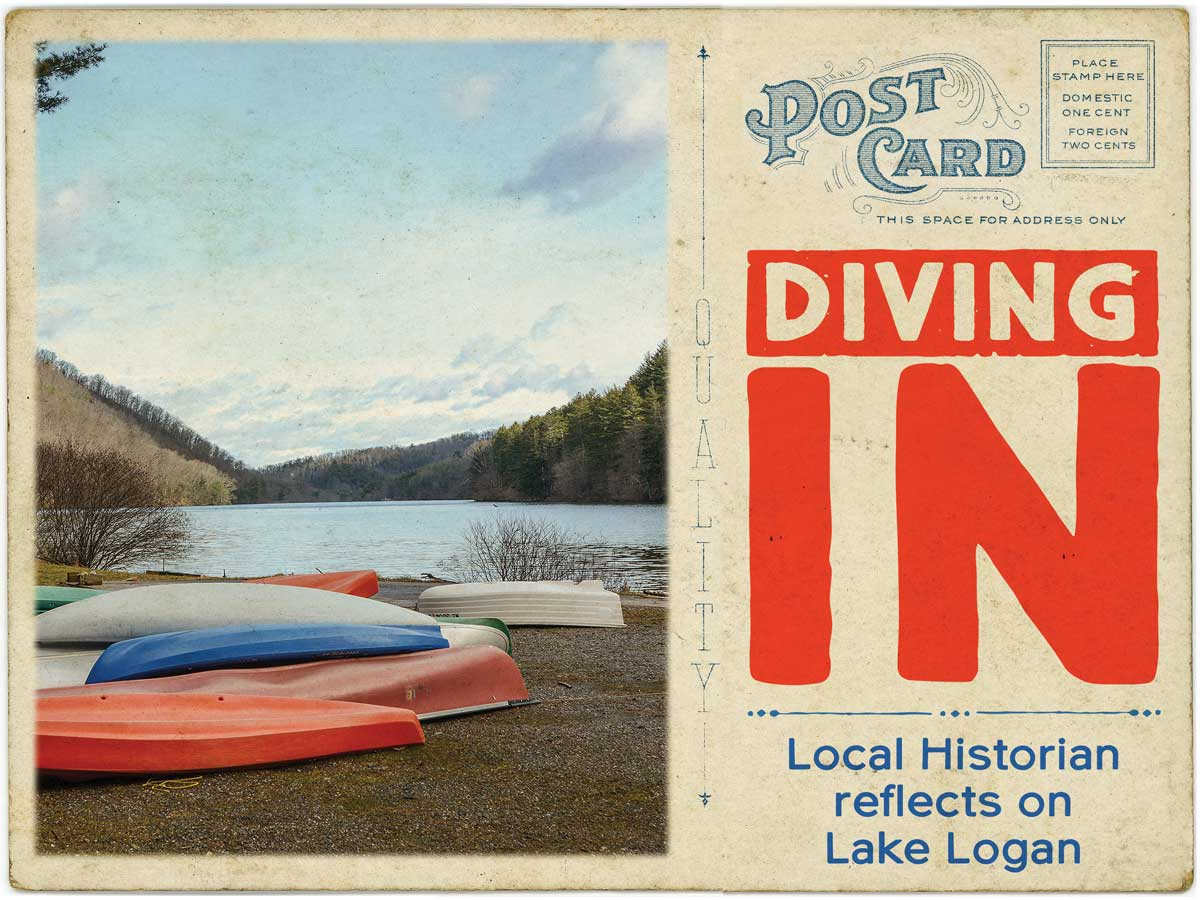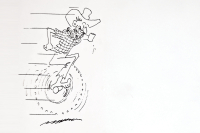Remembering Lake Logan

One of the most beautiful settings in Western North Carolina is Lake Logan, a sizable body of water captured between steep-forested mountainsides in southern Haywood County. Champion Fibre Company constructed this reservoir in 1932 on the West Fork of the Pigeon River — a tributary of the Pigeon River. Their primary purpose for doing this was to supplement the flow of water to the pulp and paper mill in Canton, especially during dry periods of low rainfall.
After Champion founder Peter G. Thomson’s original pulp mill began operation in 1908, the manufacturing demands for water steadily increased. Additional pulp and paper processing equipment was installed, which not only ramped up production but consumed more water as well. By the late 1920’s, the situation had progressed to a point whereby whims of nature reducing the amount of water flowing in the Pigeon River threatened the mill’s production — and even its survival.
Champion Fibre Company President Reuben B. Robertson — Peter Thomson’s son-in-law — was keenly aware of the difficulties posed by this capricious situation. Accordingly, between 1928 and 1932, he took the necessary steps to develop the water reserve known today as Lake Logan.
The lake property is currently owned by the Episcopal Diocese of WNC and is home to the Lake Logan Conference Center and Camp Henry. Although the paper mill enterprise at Canton no longer owns the Lake Logan property, it still holds the rights to draw water from the lake to support its manufacturing needs, just as Reuben B. Robertson had intended.

Related Items
Between 1913 and 1925, the logging village named Sunburst thrived on the site where Lake Logan was later impounded. This photo offers a view of the village looking north (downstream), with the sawmill and stacks of lumber in the distance and the log pond and residences in the foreground. Courtesy of Canton Area Historical Museum
The rise and fall of Sunburst Village
Peter G. Thomson’s Champion Fibre Company began manufacturing pulp at the Canton mill in early 1908. By June of that year, the mill was shipping eight to ten rail car loads of pulp daily to Thomson’s coated paper mill in Hamilton, Ohio. Reuben B. Robertson later remembered that the supplies of pulpwood purchased from independent timber operators and those obtained from scattered company-owned tracts barely sufficed to keep Champion Fibre “ahead of the sheriff” during those early days.
Consequently, Thomson and Robertson availed themselves of a business opportunity that would include contracting for a 20-year supply of pulpwood for the Canton mill. In early 1911, they allied Champion Fibre Company with the interests of William Whitmer & Sons. This northern investment concern controlled the new Champion Lumber Company that owned several vast boundaries of virgin timber in western North Carolina.
On the site where Lake Logan would eventually be impounded, Champion Lumber Company and later the Suncrest Lumber Company operated a large band-saw mill from 1913 until 1925. The village that quickly arose and surrounded the sawmill was named Sunburst, taking the name of Champion Fibre’s original smaller sawmill village located a few miles upstream.
Hundreds of workers called Sunburst home, living in small residences and boarding houses. The village had a hotel, commissary (or company store), barbershop, jailhouse, church, school and other such infrastructure that afforded a measure of comfort and civilization for the hardworking men and their families living in the mountain wilderness. And, in a matter of just a few years, electrical and telephone services were enjoyed by the citizens of Sunburst.
Railroad tracks linked Sunburst with the many logging camps spread throughout the headwaters of the Pigeon River. Once the timber was processed into pulpwood and lumber at Sunburst, it was hauled a short twelve miles to Canton over the Tennessee & North Carolina Railroad (T&NCRR).
Of course, the pulpwood — spruce, hemlock, chestnut, and other hardwoods — was delivered to Champion Fibre for conversion into pulp and paper. The sawn lumber product was loaded onto the Southern Railroad’s cars and shipped to customers across the east coast of the United States.
Unfortunately, a fire ravaged the Sunburst sawmill in 1920, essentially destroying everything above the mill’s concrete foundations. Equipment from Suncrest Lumber’s abandoned Crestmont sawmill in northern Haywood County was used to rebuild Sunburst, and it was not long before the band saws were humming again.
However, just five years later, a vast forest fire swept through the high country of the Pigeon headwaters and burned for three weeks. More than 25,000 acres of precious timber, as well as the rail lines accessing it, were destroyed — effectively ending Suncrest Lumber Company’s operations at Sunburst.
During the winter of 1925-1926, the heavily used sawmill equipment at Sunburst was dismantled and hauled to Waynesville, where it was again reassembled and placed into operation at the “sawmill bottom” (near today’s Waynesville Plaza).
Over the next couple of years, the once active Sunburst village became deserted. Yet, the T&NCRR remained in service, supporting a daily bus service for those people living between Canton and Sunburst.
The Sunburst timberlands owned by Suncrest Lumber — approximately 36,000 acres — were sold to Sherwood Forest Inc. in 1926. However, the sale did not include the property on which the abandoned Sunburst sawmill and village sat.
By then, Champion Fibre Company’s Reuben B. Robertson was already concerned about his pulp and paper mill’s water supply problem. Undoubtedly, he had been studying and trying to decide where to build a water reservoir and had his eye on that remaining Suncrest Lumber tract.
The property not only included 125-acres of land surrounding the West Fork of the Pigeon River, but it was also still connected to Canton by a railroad. Robertson surely realized the railroad would be invaluable for a major dam project, offering a means to haul workmen, equipment and materials to the construction site. It could also be useful in hauling away the excavated soil and rock.
In 1928, three years after the logging and sawmill operation at Sunburst shut down, Reuben B. Robertson purchased the 125-acre Sunburst tract from Suncrest Lumber Company.

Above: This photo of the Lake Logan dam construction is looking upstream. It was published in a May 1932 edition of Champion’s “The Log” magazine and reveals how the construction had advanced significantly in just a few months. Below: The July 1933 edition of Champion’s publication “The Log” presented this photo of the new Lake Logan dam and water reserve. Photos courtesy of Canton Area Historical Museum

Impounding the West Fork of the Pigeon River
The quest for more water and additional timber mounted as Champion Fibre added new machinery and increased production at the Canton mill. Spruce, especially, was a desired species of wood, and Champion gradually assembled a spectacular boundary of timberlands straddling the North Carolina and Tennessee border to ensure a supply of spruce as well as several other varieties of pulpwood.
By 1927, the paper company had built an extensive infrastructure in these same timberlands to harvest the wood. This included a large sawmill operation at Smokemont, located in Swain County, and many miles of railroad tracks snaking through the forests. But Champion was not the only party holding a keen interest in those wild lands.
Large groups of enthusiastic nature lovers in Asheville and Knoxville thought these same timberlands were better suited for park land. Spurred on by the activists, legislators in both North Carolina and Tennessee enacted condemnation proceedings to acquire Champion’s 110,000-acres of timberlands.
In 1931, after years of bitter feuding and legal proceedings, the U.S. government finally took this land, which would eventually become the Great Smoky Mountains National Park. As compensation for its precious timberlands, Champion was awarded $3 million.
That same year, the Champion Fibre Company initiated a huge development project at the Canton mill to increase its paper production. The project entailed extensions and new equipment being added to the Beater and Finishing rooms, as well as construction of a completely new machine room for installation of the world’s largest “book” paper machine.
The capital required for such a mill expansion was huge, and funding would certainly have been drawn from the $3 million settlement with the U.S. government. Importantly, such a large addition to the mill’s manufacturing facilities would require additional water for the new processes. The water reservoir that Reuben B. Robertson had envisioned at the site of the abandoned Sunburst sawmill village suddenly became crucial in keeping the mill running at full capacity during the extended dry spells.
The Sunburst property had lain idle after the sawmill equipment was removed and relocated to Waynesville in 1926. After purchasing the site in 1928, Champion occasionally sent crews there to work on cleaning up the littered property, including the remaining heaps of concrete from the building and machinery foundations.
In 1931, with the imminent start-up of the new 242-inch-wide book mill machine — the largest in the world — and using funds from the $3 million settlement, Rueben B. Robertson set things in motion to construct the new water reservoir. According to company engineer B.S. Colburn Jr., preliminary work was initiated by engineers Charles E. Waddell & Co. out of Asheville in August and September 1931.
Colburn reported in Champion’s monthly news publication, “The Log,” that in August and September Waddell Engineers made surveys of five possible locations for a water impoundment and several others were inspected. “The location at Sunburst was found to be the best, and work was started immediately on the final survey of the dam site and reservoir basin.”
A design was chosen for a single arch, concrete dam rising approximately fifty-six feet in height and extending across the lower end of the Sunburst valley, through which the West Fork of the Pigeon River flowed. Almost immediately, Champion Fibre Company’s employees began excavating on each end of the dam where the massive structure would anchor against the mountainsides.
Interestingly, a hydraulic pump was used to remove the soil from the underlying rock by blasting it away with water under high pressure. Once the bare rock was exposed and cleaned, the rock face was drilled in six separate locations with a diamond-core drill to determine the soundness of the rock abutments.
In late 1931, Champion contracted with Smith, Leach and Co., a branch of the W.W. Boxley and Co. of Roanoke, Virginia, to construct the dam. The contractor quickly mobilized and took over the excavation work from Champion Fibre Company’s crews. By the first week in February 1932, approximately 2,000 yards of earth and stone had been removed.
One might expect that the concrete pours would begin as fast as the foundation rock was exposed and cleaned. However, there was another step taken before that happened. The contractor was required to seal all the cracks and openings in the rock below the foundations.
To accomplish this feat, holes were drilled into the rock 15 feet deep. Then, cement was pumped into these holes under a pressure twice that of the water after the lake was filled. Only then, when the cracks and other openings in the rock were tightly sealed, could the concrete foundation pours begin.
Erection of forms and pouring concrete for the new dam began in early February 1932, and the work was completed in the summer of that same year. Soon after that, approximately 600 million gallons of water were impounded behind the new concrete dam, creating an 87-acre water reservoir for Champion Fibre Company.
The “Sit ‘N Whittle” heritage
An old Champion publication of “The Log” offers a tantalizing snippet about the naming of the newly impounded lake. Before construction of the dam was completed, it is revealed the new lake was christened “Smith Lake.” This was in accordance with an ancient custom in western North Carolina — since time immemorial, “The Log” states — in giving Indian names to artificial lakes.
The inspiration for the name was the great Cherokee Indian Chief Charlie Smith, “whose spirit still roams through the wilds of North Carolina.” Apparently, the inspiration was short-lived because in less than a year everyone was calling the new impoundment “Lake Logan,” in honor of Logan Thomson who was Champion founder Thomson’s son. That name has obviously stuck and is the one still associated with the pristine lake puddled on the headwaters of the Pigeon River.
Shortly after Lake Logan was impounded, Robertson began assembling a little village of log structures on the lake’s shoreline, reforesting the surrounding mountainsides, and stocking the lake and streams with bounties of trout. Several old log cabins were relocated from surrounding counties and the newly established Great Smoky Mountains National Park. Robertson’s own private cabin became known as Sit ‘N Whittle, and it along with the entire compound of lodges and lake properties soon became a place of unparalleled beauty and the nucleus for Champion’s company retreat.
Employee gatherings of all sorts were held at Lake Logan, including management and foremen’s meetings, graduation ceremonies for vocational trainees and apprentices, assemblies to honor Champion employees, gatherings of old-timers, and on and on. In the early years, these groups typically rallied in the parking area behind the Champion YMCA in Canton and were transported to and from Lake Logan in company buses.
Local civic clubs, women’s associations, hunting and fishing clubs, and various other organizations were also able to enjoy the Lake Logan facilities, where nature’s beauty and comfort were always on display. In 1933, for example, the lake property was leased for a five-year period to the Lake Logan Hunting and Fishing Club, a new organization of Haywood County sportsmen which included Reuben B. Robertson’s son, Reuben B. Robertson, Jr. Club members gained fishing and boating rights at Lake Logan where fish were reported to be “unusually abundant.”
Over the years, Lake Logan became one of the premier destination resorts in Western North Carolina. To accommodate the growing number of guests, Champion built many additional facilities around the lake. A paved airstrip added in the mid-1950’s made it possible for guests, company officials, and customers to fly into Lake Logan on Champion’s private airplanes. There were many notable public figures entertained at Lake Logan over the years, including the Rev. Billy Graham, Hubert Humphrey, Richard Nixon, George Bush, and Carl Schenck to name just a few.
In the 1960s, however, significant changes within Champion Paper and Fibre Company’s organizational structure began to take place. It has been suggested that these changes actually initiated a movement away from the paternalistic management environment which had existed at the Canton paper mill since its early origins.
Reuben B. Robertson, Jr., President of Champion Paper and Fibre Company, was killed in an automobile accident in 1960. Soon after that tragic event, his father Reuben Sr., asked to be relieved of the company chairmanship responsibility. Then, in 1966, the local Champion workers voted to unionize for the first time in the company’s history.
Each of these events — and others — not only impacted the company’s management structure and the employee relations at the Canton industrial facility but the climate at nearby Lake Logan also began to transform, or chill. Upon Reuben B. Robertson Sr’s. passing in 1972, his beloved retreat gradually lost its appeal as a place of relaxation and comfort. The notion of sitting in a rocking chair and whittling away with members of the Robertson family was gone. Instead, for the next two decades, Lake Logan simply continued to be a handy venue for Champion to host employee meetings and entertain customers.

Reuben B. Robertson assembled several old log structures on the Lake Logan property after the lake was impounded in 1932. He was especially proud of the one shown here, which became his and wife Hope’s own quarters. They named the lodge Sit ‘N Whittle. Photo courtesy of Canton Area Historical Museum
A new heritage begins
Drastic ownership transfers impacted Lake Logan beginning in the late 1990s. It was then that Champion International sold its Canton and Waynesville paper-making facilities along with the Lake Logan property to the mill employees. In the year 2000, Lake Logan was divested to the Episcopal Diocese of Western North Carolina for its present use as a conference center, while the surrounding timberland was acquired by the North Carolina Land Conservancy and transferred to State and Federal ownership.
Beginning in 2001, the Episcopal Diocese of Western North Carolina began developing the Lake Logan property into a camp and conference center designed to accommodate a wide variety of groups. At that time, construction of the Bishop Robert Johnson Dining Hall began, as well as the refurbishment of the Lodge and several historic cabins.
Lake Logan Episcopal Center opened the doors in the summer of 2002, welcoming Camp Henry to its new home. Since then, Camp Henry has taken place at Lake Logan annually and has carried on the legacy of faith, friendship, community, and environmental stewardship.
Grandparents and parents who attended Camp Henry are now seeing the same joy, transformation, and growth that they experienced in their youth on the faces of today’s campers. In 2016, the name was changed to Lake Logan Conference Center and Camp Henry Inc. Today, the property hosts thousands of people each year for retreats, recreation, reunions, outdoor education, artist gatherings, sporting and music events, and — of course — summer camp.

Lake Logan was drained for sediment removal in 1955, many remaining foundations from the old Sunburst sawmill were exposed, seen in this photo. Photo courtesy of Canton Area Historical Museum
A personal connection with the Lake Logan story
In the mid-1970s and fresh out of college, I started my own professional career with Champion at the Canton mill. One of the first engineering assignments that came my way was to survey the depths of the water at Lake Logan. More water storage was apparently required and it had been determined the lake was practically filled up with sediment.
A co-worker and I measured the depth of the lake at many points and plotted the data on a map. Using this information, the amount of sediment that could be removed from the lake bottom was determined and a project developed to dredge the lake. Upon approval of project funding, Lake Logan was drained and a local contractor hired to excavate and haul the material away.
Surprisingly, and intriguingly for this history enthusiast, several old concrete foundations were uncovered at the upper end of the lake. It turned out these were the remains of the original sawmill that had been located there. The Champion crews tasked with cleaning-up and removing what was left of the old Sunburst village and sawmill in the late 1920s had left these huge concrete artifacts in place. And that is exactly what I instructed our modern-day excavation contractor to do — leave the old concrete foundations alone! We left them for the next generation of young engineers or archaeologists to discover.
Another project awarded to me in those early days when my engineering experience was extremely raw was to install flashboards along the top of Lake Logan’s dam. It was yet another measure to increase the volume of water impounded behind the dam by increasing its height.
We simply installed short pipe columns along the concrete dam’s crest and attached sturdy wooden boards — called flashboards — to them. The dam height was raised a couple of feet or so with the flashboards, thus increasing the volume of water impounded behind it by many millions of gallons.
A decade or so after these early Champion ventures of mine at Lake Logan, another project at the Canton mill came along that was indirectly related to the Lake Logan water reservoir. This one was a little larger in scope and held a much higher level of importance.
Previous assignments in Brazil and Pensacola, Florida, building new paper mill facilities had seasoned me for this much larger challenge. I was asked to lead the Canton Modernization Project, a $300 million engineering and construction endeavor having the manifest goal of bringing the Canton paper mill into compliance with the latest air and water discharge permit requirements.
One of the most challenging requirements was to reduce the daily amount of water usage from more than 50 million gallons per day to approximately 30 million gallons per day. Engineers analyzed every use of water in the mill, and many modifications were made to the pulping and paper-making processes to achieve the required reductions.
The fact that the mill succeeded in achieving this water reduction goal, along with meeting the other water and air permit requirements, is something this local Canton boy will never forget.
Local author Carroll C. Jones was born and raised in the papermill town of Canton, located in the heart of western North Carolina’s mountains. He is descended from the Hargrove, Cathey, Shook, Moore, and Crymes families who pioneered Haywood County. His latest book is titled Thomson’s Pulp Mill: Building the Champion Fibre Company at Canton, N.C.—1905 to 1908. Find out more about Carroll’s books at carrolljones.weebly.com.









